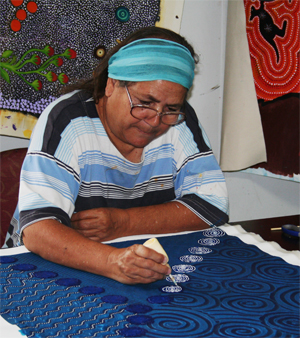Story Telling – Legal Issues
What is storytelling?
This information sheet considers the art of oral storytelling in which the form or words used to express a story can change with each telling. It is a fluid art form and includes both traditional and folk tales handed down through generations as well as new stories.
What legal issues can arise?
The main legal issues are:
- Copyright
- Moral Rights
- Performer’s Rights
- Indigenous Cultural Intellectual Property.
Copyright
Copyright protects your creative work from being copied or used without your permission. Copyright only protects specific things, such as artworks, musical works, literary works, dramatic works (eg plays, choreography) and films and sound recordings. Literary works can include stories, novels, poems, song lyrics or the content on a blog.
The law of copyright raises a number of issues for storytelling, in particular traditional storytelling, because the stories are usually oral stories, handed down through generations and tend to belong to communities rather than identifiable individual creators. These kinds of stories do not fit neatly into Australian copyright law protection, as explained below.
Firstly, copyright does not protect a literary work, unless it is expressed in a material form – meaning the words must be put down or recorded in some way, e.g. written down, filmed, in an email, recorded on a USB stick or in a sound or film recording. That’s why copyright does not protect a mere idea for a story, if it is not written down. It’s also why copyright does not protect an oral story which is not written down. This is an issue for traditional stories which have never been recorded in some way. Once they are written down, copyright will only apply to the particular way the story has been expressed and recorded, and not the idea in general.
Another issue for traditional stories is that copyright only protects ‘original’ stories, meaning those which originate with the storyteller, and are not copied. It might be argued that a story handed down by Aboriginal and Torres Strait Islander peoples through generations of oral storytelling, is not ‘original’ because it was not created or authored by the current storyteller. Their stories usually do not have identifiable individual creators, but rather belong to communities. Australian copyright law does not recognise communal copyright ownership. However, copyright protects the particular language used to express a story and not the plot or theme of the story. As such, Arts Law considers where a storyteller uses their own unique expression of a traditional story, then that story is original. This can be compared to a storyteller who expresses a story in words which are not the product of their own imagination but have been learned and are recited.
There may also be an issue around copyright ownership of the oral story once it is in material form. Usually the storyteller as the ‘creator’ or ‘author’ of a literary or dramatic work, owns the copyright in the story. The general rule is that the “creator” of a literary, artistic, dramatic or musical work and the “maker” of a film, sound recording, broadcast or published edition are the copyright owners. However, exceptions to the general rule include situations where either the creator is an employee, is commissioned to create the work, is a freelancer, or the work was created under the direction and control or first published by the Government.
One difficulty is that the person who puts the story into material form – for example, writes the story down or films or records the storyteller – is often not the storyteller. That person might argue that as they have given the story its ‘material form’, they are in fact the owner of any copyright in the story, and not the storyteller. An answer to this would be that the person listening to the story and either writing it down or recording it does not contribute any authorship to the expression or telling of the story and is not the source of its originality, thus cannot claim ownership of the copyright in the resulting literary work. Best practice is to have a written agreement in place stating that the Aboriginal or Torres Strait Islander storyteller owns copyright in the story.
Another complication is where the recording of the story is not in writing but is a film or sound recording. Separate to the copyright in the oral story (which comes into existence as soon as it is recorded), there is copyright in the film or sound recording itself. The copyright owner of the film or sound recording controls the use of the film/sound recording. The issue is that the copyright owner of the film or sound recording, is usually not the storyteller but someone else. There are different scenarios depending on whether the recording is commissioned or not. If someone commissions a film or sound recording, meaning they pay for it to be made (for example, it could be a university or a corporation), then they will own the copyright in the recording. If it is an uncommissioned film, then the copyright owner of the film will be the person who made the financial arrangements for the film to be made (usually the producer). If it is an uncommissioned sound recording, then copyright will be owned equally by the owner of the medium in which the recording is embodied and each of the performers – who might include the storyteller! These scenarios can be changed by written agreement.
Clearly, the question as to whether copyright exists in a story and if so, who owns it, is a difficult one. It becomes more complicated when it is filmed or sound recorded, as there may be other copyright owners with competing interests.
Moral rights
A creator of an original literary or dramatic work has moral rights which recognise the creator’s ongoing connection with the work. So, a storyteller who is the creator of an original literary work in material form has:
- the right of attribution (to be named as the creator);
- the right against false attribution (not to have their name associated with stories or works which they did NOT create); and
- the right of integrity (meaning no derogatory treatment of the story in a way that prejudices the reputation or honour of the creator).
As such, a person who writes down, films or records a story told by the storyteller may breach the storyteller’s moral rights in that story if they:
- do not acknowledge the storyteller as the story’s original author;
- use the story in a way which amounts to derogatory treatment which could have a negative impact on the storyteller’s reputation.
For more information refer to the Moral Rights Information Sheet.
Performers’ Rights
In addition to having a right of copyright in the story and moral rights in respect of the story itself, a storyteller may have ‘performer’s rights’ in respect of their live performance.
Under Australian law, performers’ rights apply to performers of live performances (whether in the presence of an audience or otherwise) which are:
- a dramatic work, or part of such a work, including a performance given with the use of puppets;
- a musical work or part of a musical work;
- a dance;
- a circus act or a variety act or a similar presentation or show;
- an expression of folklore; or
- a reading, recitation or delivery of a literary work or part of a literary work, or an improvised literary work.
Oral storytelling could be considered to be a live performance of a literary work, or an improvised literary work, a dramatic work or an expression of folklore (such as Aboriginal and Torres Strait Island traditional cultural stories). This means that the storyteller has the following rights as a performer (known as performer’s rights):
- The right to prevent unauthorised audio or film recording, or the communication to the public by radio or television broadcast or over the internet, of their spoken performance. (However, permission is not required in relation to making “exempt” recordings, which includes certain recordings for domestic use, scientific research, and educational purposes. Further, the performer’s permission is not needed to make or use recordings for reporting the news or current affairs, criticism or review or for judicial proceedings or legal advice.)
Once a performer has consented to a recording or broadcast of their performance to be made, the performer generally has no further rights in relation to that ‘authorised’ recording and cannot prevent its use except:
- the right to say whether the recording can be used as a soundtrack for a film; or
- if the performer had made an express limitation on use at the time consent was given to record.
- A share in the ownership of the copyright in a sound recording of their live performance unless:
- they gave the performance as an employee; or
- someone else commissioned the sound recording (paid the producer to make the sound recording).
- Moral rights, in respect of the live performance and of the sound recording of that performance, to be attributed and not falsely attributed as the performer, and the right not to have their live or recorded performance subjected to derogatory treatment that could damage their reputation.
For more information refer to the Performers’ Rights Information Sheet.
Indigenous Cultural Intellectual Property
A story may embody Indigenous cultural intellectual property (ICIP)
ICIP refer to Indigenous people’s interests in their cultural heritage, which includes songs, music, dances, stories, ceremonies, symbols, languages and designs. ICIP is a communal rather than an individual interest. An artist who uses ICIP in artwork may have duties and obligations to their community or tribal group in respect of that ICIP and the way it is used. ICIP is not recognised under Australian law but Arts Law believes it is important that it is acknowledged and respected.
Permission should be obtained from the traditional owners of the Indigenous heritage before using Indigenous objects, knowledge or works. The traditional owners should be consulted on how the community should be attributed and given the opportunity to approve the way in which the material is used. In some circumstances it may be appropriate to use a notice of custodial interest, which could read as follows:
Notice of Custodial Interest of the *[NAME]* Community
“The story/performance embodies traditional knowledge of the *[NAME]* community. Dealing with any part of it for any purpose that has not been authorised by the custodians is a serious breach of the customary laws of the *[NAME]* community, and may also breach the Copyright Act 1968 (Cth). For enquiries about permitted reproduction of the traditional knowledge embodied in this work, cultural consents should be obtained. Contact *[STORYTELLER’S]* to enquire further.”
Protocols have been developed which provide guidelines for appropriate conduct when interacting with Indigenous people and their communities. Protocols are made in good faith and encourage mutual respect. They are not legally binding, unless inserted into a contract making the parties bound by the protocols. Arts Law strongly urges artists and all others dealing with works which embody ICIP to act consistently with the any relevant protocol.
The Australia Council for the Arts has produced a set of protocls for working with Aboriginal and Torres Strait Islander creatives and using Indigenous Cultural and Intellectual Property in the arts and cultural sector. These Protocols are available for free and can be downloaded from the Australia Council’s website Protocols for using First Nations Cultural and Intellectual Property in the Arts or by contacting the Australia Council.
Additional protocols include Arts Tasmania’s Respecting Cultures: Working with the Tasmanian Aboriginal Community and Aboriginal Artists designed as a companion text to the Australia Council’s protocols providing a specific Tasmanian perspective. It can be downloaded from the Arts Tasmania website www.arts.tas.gov.au or telephone: (03) 6233 7308, free-call: 1800 247 308 or email: [email protected].
Screen Australia has developed Pathways & Protocols: A Filmmaker’s Guide to Working with Indigenous People, Culture and Concepts which is available on the Screen Australia website which is available on Screen Australia’s website.
See also the Arts Law publications:
- Cultural and Intellectual Property Policy – Indigenous Stories
- Cultural and Intellectual Property Policy – Academic Research
Disclaimer
The information in this information sheet is general. It does not constitute, and should be not relied on as, legal advice. The Arts Law Centre of Australia (Arts Law) recommends seeking advice from a qualified lawyer on the legal issues affecting you before acting on any legal matter.
While Arts Law tries to ensure that the content of this information sheet is accurate, adequate or complete, it does not represent or warrant its accuracy, adequacy or completeness. Arts Law is not responsible for any loss suffered as a result of or in relation to the use of this information sheet. To the extent permitted by law, Arts Law excludes any liability, including any liability for negligence, for any loss, including indirect or consequential damages arising from or in relation to the use of this information sheet.
© Arts Law Centre of Australia
You may photocopy this information sheet for a non-profit purpose, provided you copy all of it, and you do not alter it in any way. Check you have the most recent version by contacting us on (02) 9356 2566 or tollfree outside Sydney on 1800 221 457.
The Arts Law Centre of Australia has been assisted by the Commonwealth Government through the Australia Council, its arts funding and advisory body.




